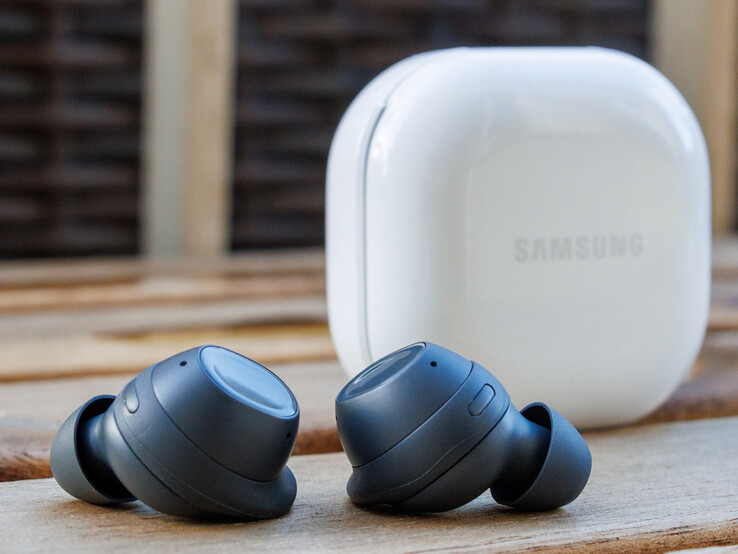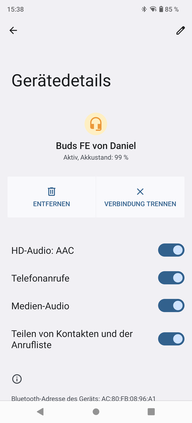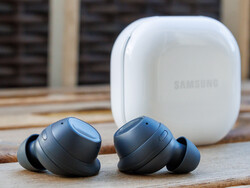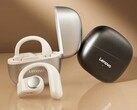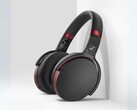Samsung Galaxy Buds FE review - Long-lasting headphones with powerful sound
In terms of the recommended retail price (RRP), the Samsung Galaxy Buds FE are positioned below the Galaxy Buds2 Pro and Galaxy Buds2, yet they still promise first-class sound for everyone.
These true wireless headphones (TWS) come equipped with ANC and HearThrough features, and can also be tracked using SmartThings Find.
Specifications
| Wearable | In-Ear |
| Connectivity | Bluetooth 5.2 |
| Range | 32.8 ft |
| Speaker | 1 way speaker |
| Audio codecs | SBC, AAC, SSC |
| Battery capacity | 60 mAh (earphones), 479 mAh (charging case) |
| Charging port | USB-C |
| Wireless charging | No |
| Weight | 5.6 g (earphones), 40 g (charging case) |
| Firmware version | R400NXXU0AWHF |
| Delivery content | Charging case, earbuds, ear tips (S, M, L), wingtips(S/M, M/L), documentation |
| Price (RRP) | US$69.99 |
Case and ergonomics - Galaxy Buds+ reloaded
The Samsung Galaxy Buds FE are available in black (Graphite) and white (Mystic White). The differences between the two versions are limited to the earphones and the interior of the charging case, as both versions come with a high-gloss white plastic case. Despite the slightly bulky appearance, the earphones weigh less than 0.21 oz and bear a resemblance to the Galaxy Buds+ from 2020, particularly due to the replaceable fin, known as wingtips by Samsung.
The overall quality is good, with no notable issues. While the plastic used in both the charging case and the earphones may not exude a high-end feel, they present a solid feel. Despite the high-gloss surface, the case is resistant to fingerprints.
When inserted into the ear canal, the earphones penetrate quite deep, especially with the smallest attachment size. The pre-installed medium size may feel a little tight for some users. Notably, the fin provides additional support behind the Anthelix, ensuring that the Samsung headphones stay securely in place, even during sports activities or rapid head movements.
Features and operation - Galaxy Buds FE with a neat overall package
The Samsung Galaxy Buds FE boasts a comprehensive set of features, including active noise cancellation (ANC), HearThrough for ambient noise awareness, and Bluetooth-based localization. However, it's important to note that these in-ear headphones lack IP certification for water and dust resistance and do not support wireless charging. Additionally, the Dual Bluetooth feature is not available.
Setting up the Galaxy Buds FE is a swift and straightforward process using Microsoft Swift Pair on Windows PCs. Unfortunately, Google Fast Pair is not supported. Samsung smartphone users will experience seamless pairing, as the device automatically recognizes the headphones and suggests pairing. For Apple product users, conventional pairing methods apply. The Galaxy Wearable app, available on the Galaxy Store or Play Store, facilitates firmware updates and allows users to configure basic functions such as touch controls, noise controls, and the find function.
The latter helps locate misplaced earphones by making them emit a ringing sound. Samsung smartphone users can also leverage SmartThing Find to display the last known location of the Galaxy Buds FE on a map. This feature extends to individual earbuds, allowing users to actively search for them via Bluetooth.
An additional practical feature is the control widget for Android. This widget provides at-a-glance information about the charging status and offers buttons to toggle sensor surfaces and control noise settings.
Sound - Samsung headphones with SSC
The Samsung Galaxy Buds FE differs from the Galaxy Buds2 Pro by featuring a single one-way speaker per earphone, as opposed to a two-way system. Despite this distinction, the pink noise measurement reveals strikingly similar characteristics. Subjectively, the drivers of the Galaxy Buds FE impart a more robust and richer impression compared to the top model, resulting in a compelling audio experience for both music and movies. It's worth noting that the more potent SSC codec is exclusive to Samsung products; others are limited to SBC or AAC.
Equipped with three microphones per earphone, these Galaxy headphones offer favorable conditions for both ANC and telephony. The in-ear design inherently provides passive noise isolation, further augmented by the ANC. While the ANC performs satisfactorily, some background noise may still be perceptible. The HearThrough function effectively allows external voices to be heard clearly, but ambient noise remains prominent.
In terms of telephony, the Galaxy Buds FE delivers a somewhat average performance. In quiet environments, voice quality is good, though the user's voice may sound slightly muted. In busier surroundings, such as main roads, comprehension can be challenging, accompanied by occasional dropouts. If used in a home office setup, for instance, the TWS headset can also be employed with a single ear.
| Loudspeakers | |
| THD | |
| Samsung Galaxy Buds FE (RMS: -3.0 dBFS) | |
| Jabra Elite 5 (RMS: -2.9 dBFS) | |
| Huawei FreeBuds 5i (RMS: -2.4 dBFS) | |
| THD+N | |
| Samsung Galaxy Buds FE (RMS: -3.0 dBFS) | |
| Jabra Elite 5 (RMS: -2.9 dBFS) | |
| Huawei FreeBuds 5i (RMS: -2.4 dBFS) | |
* ... smaller is better
THD (Total Harmonic Distortion): Harmonic distortion quantifies the distortion caused by non-linear components (harmonic content) in relation to the original signal. THD specifically refers to the fundamental component. It's important to note that while the term "distortion factor" is often used interchangeably, it actually refers to the overall signal, not just the fundamental component.
THD+N (Total Harmonic Distortion + Noise): This value is comparable to THD, but in addition to measuring the interference power of harmonics, it also takes into account the impact of noise as an effective value. For the measurement, a low harmonic sinusoidal signal (typically at 1 kHz and > 0 dB) is played back through the headphones under test. This signal is then recorded by a linear measuring microphone (placed at a measuring distance of approximately 0.40 inches) in an artificial head.
Both values are expressed as percentages. The lower the value, the higher the fidelity of the signal.
Samsung Galaxy Buds FE audio analysis
(+) | speakers can play relatively loud (93 dB)
Bass 100 - 315 Hz
(±) | reduced bass - on average 11.9% lower than median
(+) | bass is linear (4.2% delta to prev. frequency)
Mids 400 - 2000 Hz
(±) | higher mids - on average 7.1% higher than median
(+) | mids are linear (6.2% delta to prev. frequency)
Highs 2 - 16 kHz
(-) | very high highs - on average 15.3% higher than median
(±) | linearity of highs is average (7.4% delta to prev. frequency)
Overall 100 - 16.000 Hz
(±) | linearity of overall sound is average (21% difference to median)
Compared to same class
» 57% of all tested devices in this class were better, 7% similar, 36% worse
» The best had a delta of 4%, average was 24%, worst was 134%
Compared to all devices tested
» 57% of all tested devices were better, 7% similar, 36% worse
» The best had a delta of 4%, average was 24%, worst was 134%
Jabra Elite 5 audio analysis
(+) | speakers can play relatively loud (91.7 dB)
Bass 100 - 315 Hz
(-) | nearly no bass - on average 19.9% lower than median
(+) | bass is linear (5.6% delta to prev. frequency)
Mids 400 - 2000 Hz
(±) | reduced mids - on average 10.8% lower than median
(±) | linearity of mids is average (8.3% delta to prev. frequency)
Highs 2 - 16 kHz
(±) | higher highs - on average 12.8% higher than median
(±) | linearity of highs is average (9% delta to prev. frequency)
Overall 100 - 16.000 Hz
(±) | linearity of overall sound is average (26.2% difference to median)
Compared to same class
» 80% of all tested devices in this class were better, 4% similar, 16% worse
» The best had a delta of 4%, average was 24%, worst was 134%
Compared to all devices tested
» 80% of all tested devices were better, 4% similar, 16% worse
» The best had a delta of 4%, average was 24%, worst was 134%
Battery life - Over six hours during testing
The Galaxy Buds FE has a battery life of up to six hours, according to Samsung. They exceeded this estimate in our test at a loudness level of 65 dB(A).
Three more charges are provided by the charging case.
| Battery Runtime - Spotify loop at 65dB/A (incl ANC) | |
| Jabra Elite 5 | |
| Samsung Galaxy Buds FE | |
| Huawei FreeBuds 5i | |
Verdict - Galaxy Buds FE focusing on the essentials
Samsung offers a reliable, genuine wireless headset that does not compromise on features with the Galaxy Buds FE. This encompasses effective ANC, which performs well but doesn't reach peak levels. The sound is both pleasing and robust, and the battery life is impressive.
If you prefer to listen to music or watch movies on the go, the Samsung Galaxy Buds FE are an excellent choice.
However, it's worth noting that features like wireless charging or IP certification are not included. The absence of dual Bluetooth is a notable drawback, making the Buds FE less than ideal for home office use. This limitation is also reflected in the somewhat mediocre voice quality.
Sennheiser CX True Wireless and Teufel Airy TWS are two decent alternatives to the Samsung headphones.
Price and Availability
Transparency
The selection of devices to be reviewed is made by our editorial team. The test sample was provided to the author as a loan by the manufacturer or retailer for the purpose of this review. The lender had no influence on this review, nor did the manufacturer receive a copy of this review before publication. There was no obligation to publish this review. As an independent media company, Notebookcheck is not subjected to the authority of manufacturers, retailers or publishers.
This is how Notebookcheck is testing
Every year, Notebookcheck independently reviews hundreds of laptops and smartphones using standardized procedures to ensure that all results are comparable. We have continuously developed our test methods for around 20 years and set industry standards in the process. In our test labs, high-quality measuring equipment is utilized by experienced technicians and editors. These tests involve a multi-stage validation process. Our complex rating system is based on hundreds of well-founded measurements and benchmarks, which maintains objectivity. Further information on our test methods can be found here.





